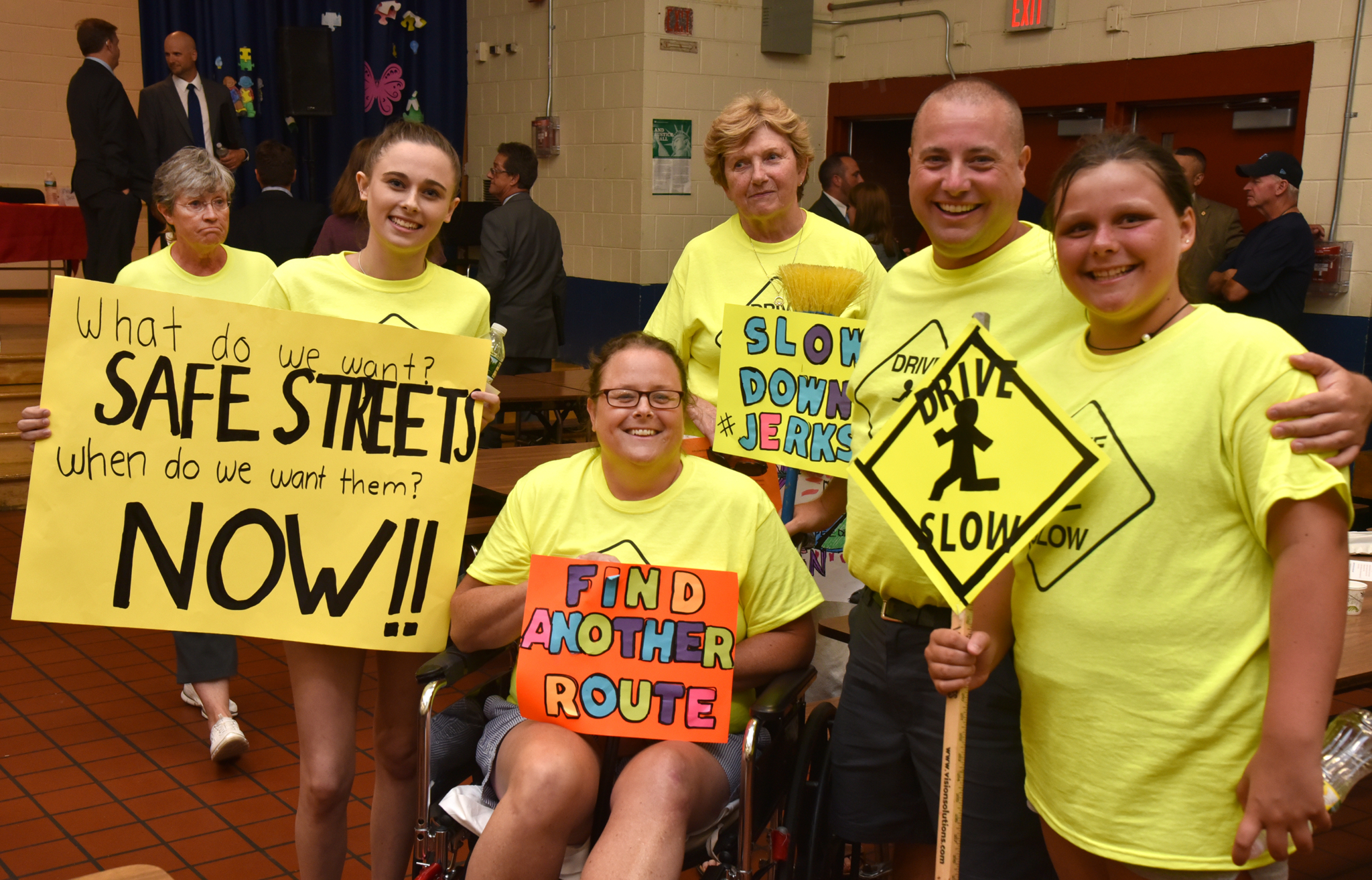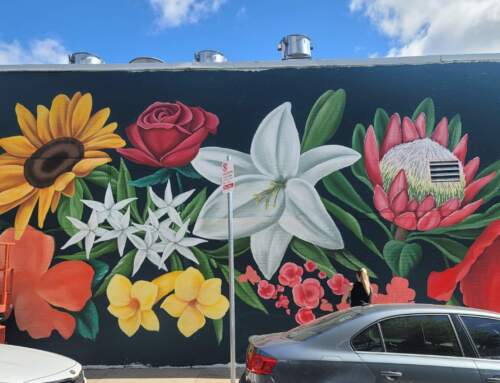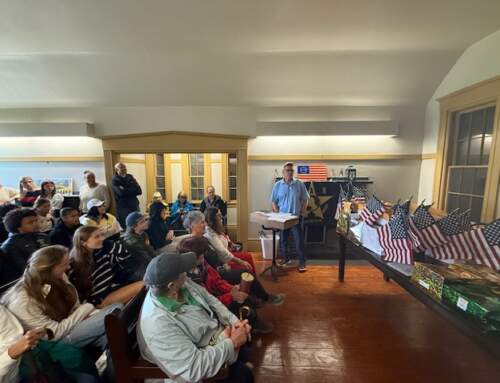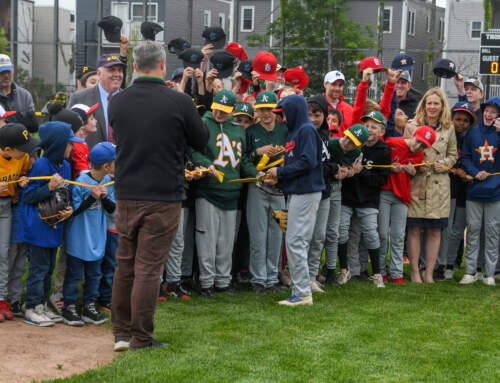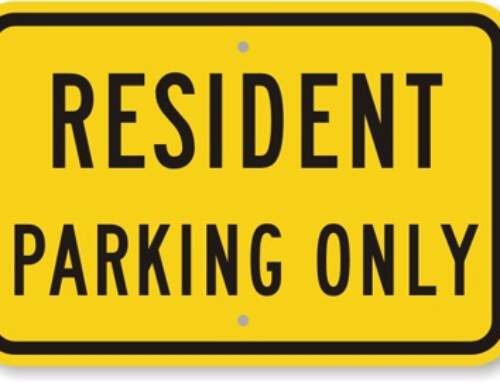By Richard Campbell
In the wake of the cruel death of an innocent child, as well as a longer history of tragic accidents on our streets, South Boston residents gathered for a public traffic safety meeting at the Tynan School on this past Thursday evening. South Bostonians revealed a unified rage, tempered by community respect, that has been earned in sorrow. As the flier from the South Boston Families for Safe Streets noted, six pedestrians, including three small children, have been struck on South Boston streets in the past two months alone. If there was any public official under the illusion that they haven’t been put on notice to move into action, surely the message has been sent loud and clear. Citizens in this neighborhood are tired of getting the brush off regarding safety of their streets, and they are demanding swift action.
The community was in action before the meeting began with the SLOW DOWN walk on L Street covering the area where Collin McGrath was killed two weeks ago, and citizens activists came prepared with a list of demands, spotted easily throughout the hall with their bright fluorescent shirts. In the beginning of the meeting, the call to order and pledge of allegiance, was led by senior Michael Donovan, Clerk of Superior Courts. A remembrance and prayer by Father Casey of Gate of Heaven, who quoted Saint Mother Theresa in saying “Life is beauty, let us all be mindful of the beauty of life…”
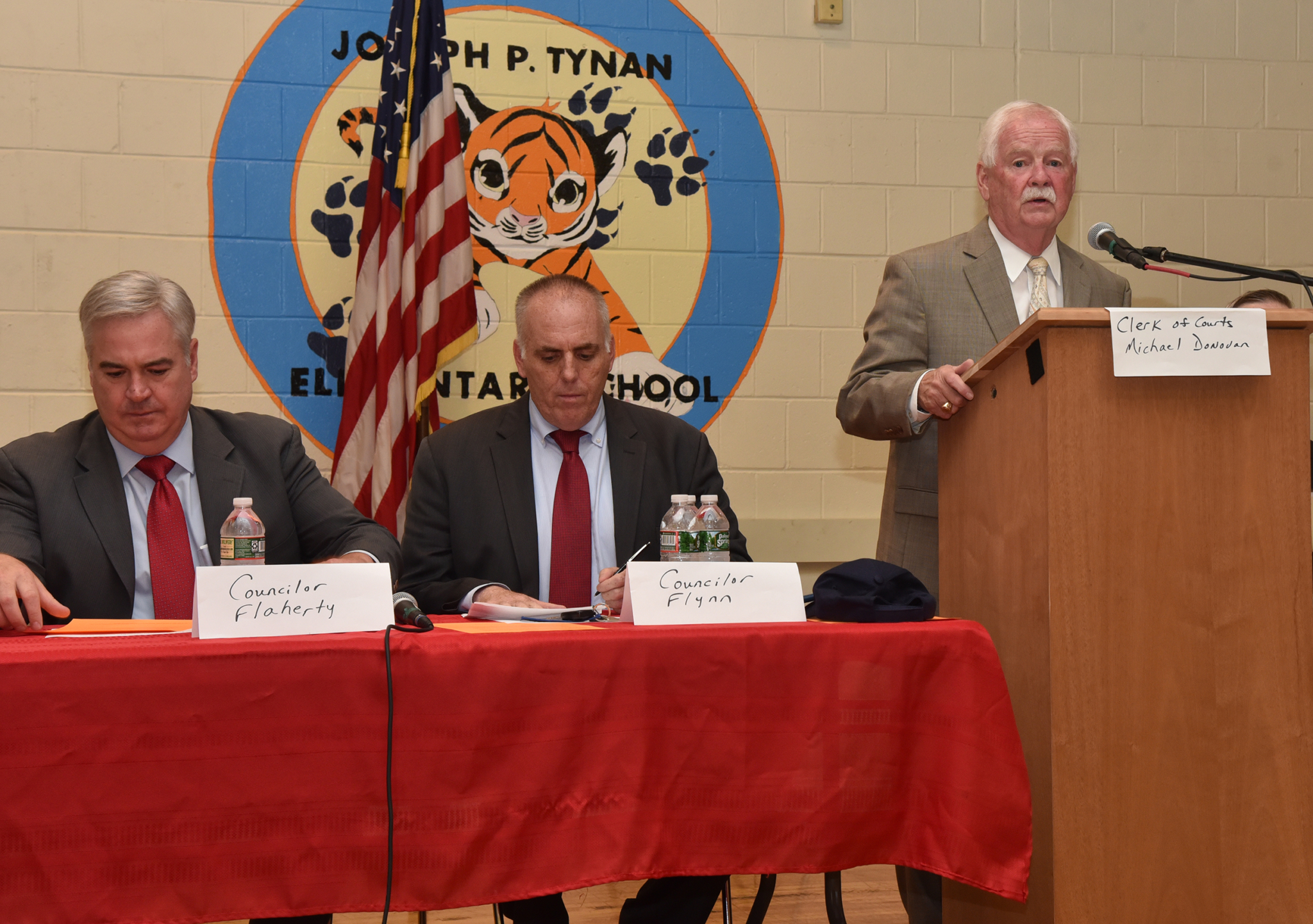
The multiple levels of officials that lined the Tynan School stage from city, to state, and federal governments revealed the seriousness of this meeting. While South Bostonians would expect Congressman Stephen Lynch, Councilors Ed Flynn and Michael Flaherty to be in attendance, it is a rare moment indeed to see the department heads of state and federal bureaucracies in attendance at such public meetings. Mayor Martin Walsh was not present, but instead sent city officials to represent his concerns. Citizens in the neighborhood made certain that no official will forget the intimidated, harassed, wounded, and especially the tragically killed pedestrians- victims that have perished one after another within plain view on the streets of South Boston.
Boston Transportation Department (BTD) Commissioner Gina Fiandaca was the first to speak on the panel and offered her condolences as well as introducing members of the city planning department who noted some of the improvements made since the tragedy and pledged the mayor’s support of significant action. Patrick Hoey, South Boston’s city planner for the BTD, outlined some of the immediate steps that were taken in the last few weeks. The L street flex posts, speed feedback signs, and other optical cues installed at intersections for both motorists and pedestrians, as well as promised more permanent improvements. He sighted that already speeds have decreased along this corridor since these first improvements were made. He also proposed a neighborhood wide comprehensive traffic plan in coordination with other departments including DCR, MASSPORT, the police departments and city officials.
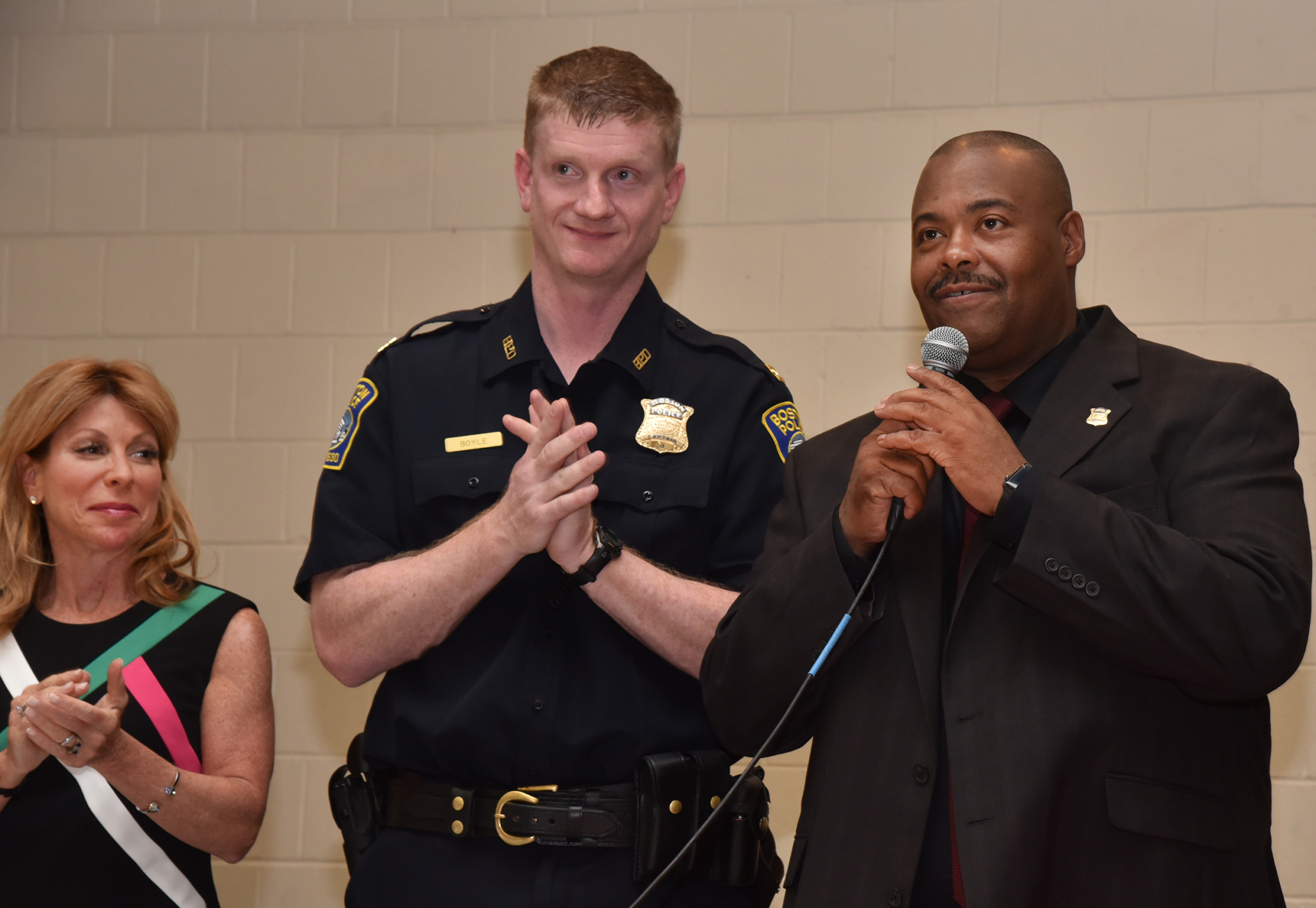
This accident being a matter primarily of the Boston Police, the newly sworn in Commissioner of Police William Gross, who was received with exceptional warmth from the community, offered condolences to the McGrath family, and provided input recognizing the past inaction on the part of officialdom controlling the traffic in South Boston. At the center of the argument is that officials have been “aware” of the problems in South Boston and promised action, but there are more officers needed to ensure enforcement. He mentioned that 60% of traffic violations were from people outside the community, and 40% came from residents of South Boston, but emphasized that “everyone needs to pay attention” when navigating our streets, and that people “will pay for violations.”
At the heart of the problem is not merely speeding and reckless driving, but the sustained increase in motorists, residents, development, and drive through traffic that has created a situation that is complex and not easily resolved. Michael Flaherty spoke about the ongoing efforts to improve safety, saying “It’s our job to keep everyone’s feet to the fire to make our community safe as possible.” City Councilor Ed Flynn noted that he talked to many residents and mentioned his twelve-point plan, which was the start of a complete traffic plan including, stop signs, speed limits and police enforcement as well as other recommendations. Flynn said: “We all know that South Boston has changed over the years, but one thing that has always remained the same is the spirit and kindness of its people.” State Senator Nick Collins mentioned the history of accidents that personally have affected him, and how it has focused a lot of his attention on Day Blvd. and emphasized that he will increase efforts to bring safety standards to ensure public safety in all areas of South Boston.
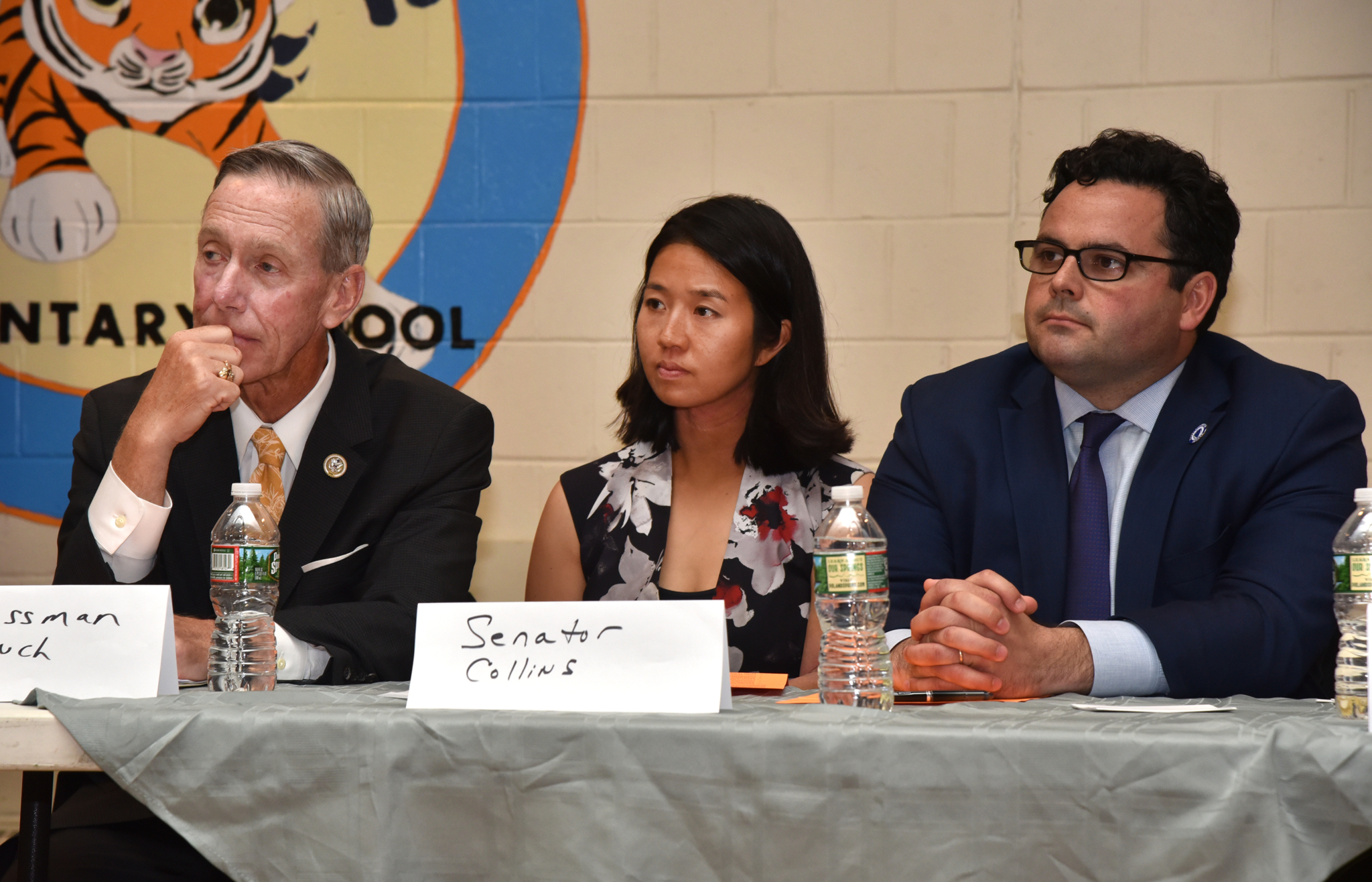
Congressman Stephen Lynch graciously invited Michelle Wu, City Councilor at Large, up to the stage as she had been sitting in the audience quietly taking notes. After giving condolences to the McGrath family, Lynch mentioned that fellow employees of Dr. McGrath at Mass General when taking a tour of South Boston after ceremonies at Gate of Heaven, had all noted the community spirit, with the blue ribbons on doors and universal empathy among our neighbors. He remarked that South Boston borders two out of the three major business office areas of Boston (the Seaport and Downtown), making it the target of significantly increased traffic from recent developments. Lynch noted that officials have to “anticipate” the problems that this causes, rather than being “reactive”. Congressman Lynch further made it clear that solutions have to be tailored to the various neighborhoods of South Boston, introduced some of the state and federal officials who manage new and ongoing plans and promised to pursue funds in Washington to make things happen.
Art Kinsman of the NHTSA, who had family roots here in South Boston, spoke briefly about how their role often involves changing the behavior of drivers and complimented the community participation and passion. Kinsman stated: “Speeding still is probably the biggest killer out there on the road, along with other unsafe driving behaviors. Most of the crashes that happen are preventable.” He mentioned Mothers Against Drunk Driving (MADD) as an example of citizens groups that changed the world and encouraged South Bostonians to keep up their civic participation. Jeff McEwen, Division Administrator Massachusetts Division of the Federal Highway Division, who acknowledge he is from away, mentioned his departments work in safety audits for Day Blvd., and the innovative STEP program, which means Safe Transportation for Every Pedestrian.
Jonathan Gulliver of Mass Dot, the state highway department, talked at length about various roles Mass Dot plays in cooperation with various other departments, and provided a laundry list of financed programs, grants, and capital projects. His talking points about the South Boston waterfront and Seaport, included a description of “improvements” in an attempt to lessen the cut through traffic going to the Seaport and enhanced pedestrian safety actions on Day Blvd. The fact that DCR is the “owner” of Day Blvd. raised eyebrows, as the highway department would seem to be the more logical “owner” of the roads. State policeman, Major Ball from the South Boston Barracks, brought a along a group of officers, and discussed their partnership with the Boston Police, to enforce violations along Day Blvd. He emphasized that only 10% of tickets delivered in South Boston on their patrol are on residents, but the majority are from Bostonians from other neighborhoods.
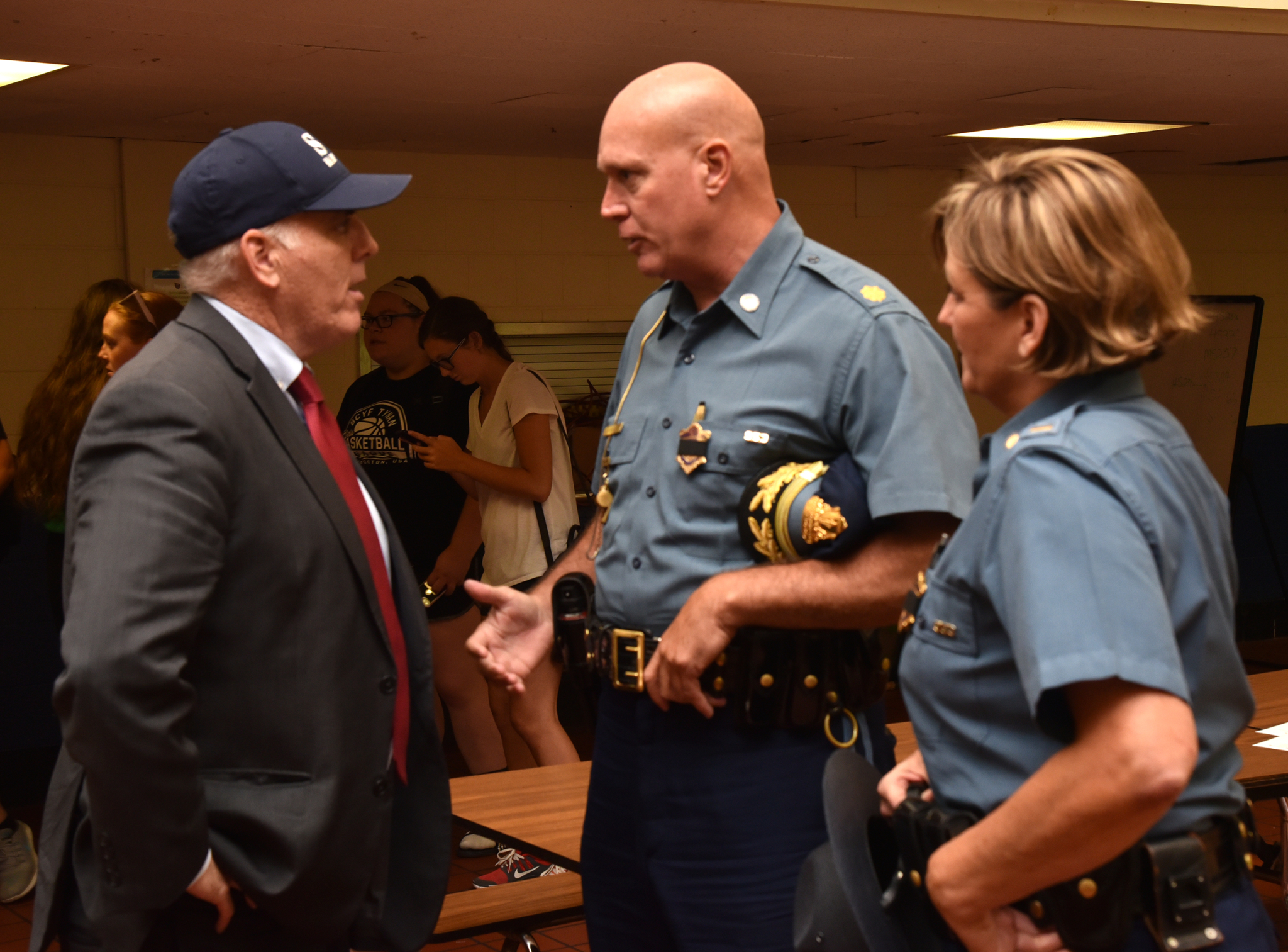
After this the question and answer session began with admonishments about “them” and “Us” mentality by Michael Donovan, and explicit encouragement for people to respect everyone in the room. While space does not provide for including the comments of all South Bostonians, this writer would be remiss if he did not mention in detail the first few passionate speakers Kati Donovan and Deidre Habershaw who kicked off the session. Kati Donovan with her team at her side wearing the bright t-shirts posed the following question: “Were you aware that there was a safety issue on the streets of South Boston?” To which members of the panel answered affirmatively. Donovan told the panel that Day Blvd has become a “raceway” and repeated the statistics of accidents on the streets. Noting that she herself had been in an accident May 31st, when she and her son were hit by a car and injured, she pleaded for the safety of others.
With demonstrable anger Donovan noted to officials: “That 25 million-dollar plan that you talked about has little to zero interest in keeping the South Boston residents safe.” She mentioned that according to the 2016 census South Boston has increased its population by 14. 2% as opposed to rest of city at only 5.5%. Like others she emphasized the infrastructure has not changed significantly in South Boston to accommodate the cut through traffic created largely by downtown businesses. She emphasized that South Boston was denied entrance into the safe streets program and made it clear that her group would not allow the neighborhood to be ignored any longer. As she delivered the six-point list of demands for her group and thanked all the others who worked on the community project, cheers and clapping resounded throughout the hall. In closing she mentioned: “this will definitely not be the last time we have a SLOW DOWN,” ensuring the community will remain vigilant in the future.
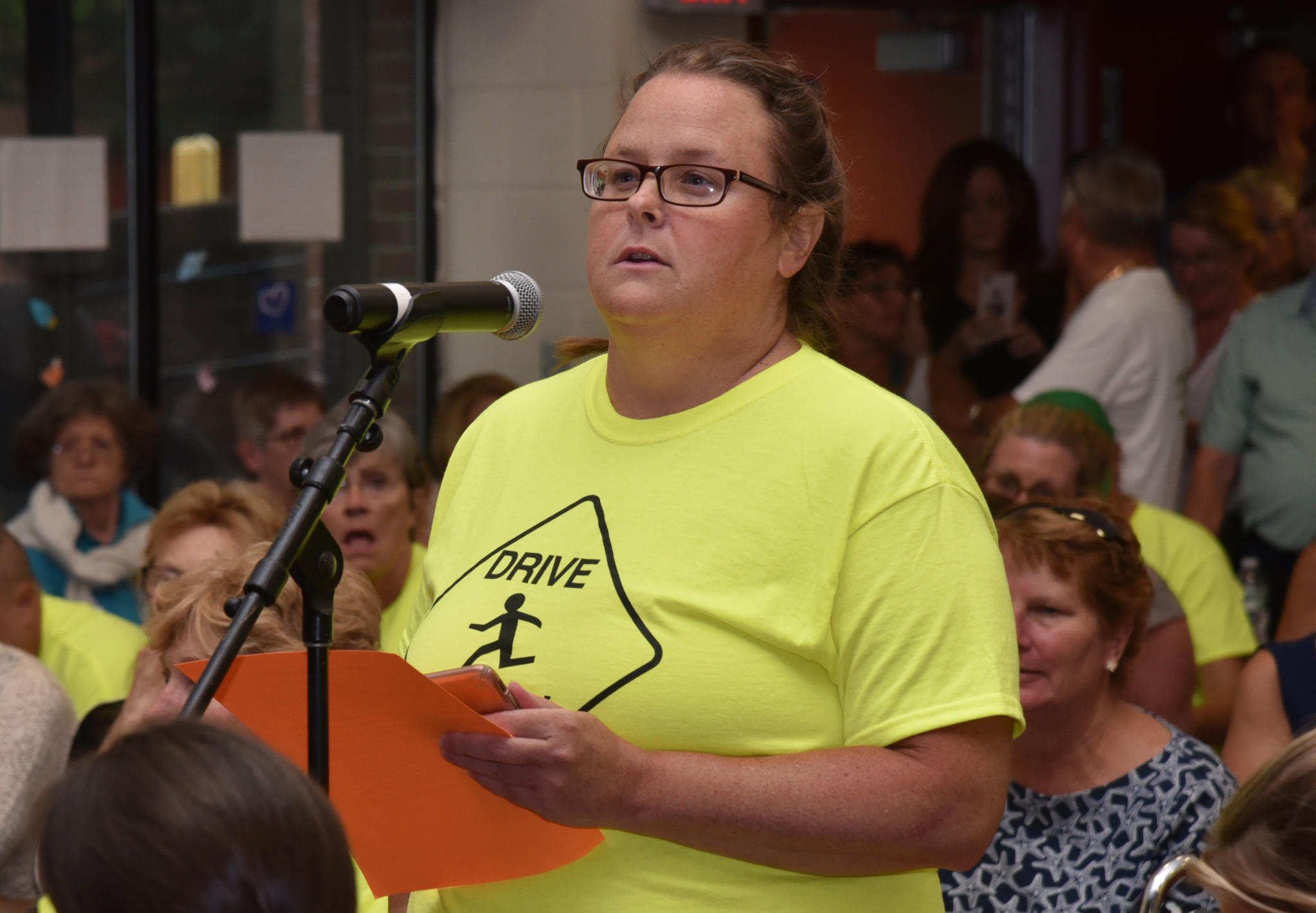
The other citizen who had been the victim of a tragic accident that killed her father Billy McDermott was Deidre Habershaw. In a quiet tone she bitterly chastised officials who knew her father personally and still stood by for years “and achieved practically nothing.” “I have been polite, and I have been patient and all I’ve got for that is some increased light on Day Blvd.” Clearly shaken by having to recount the incident she imagined that if she had been killed instead of her father, her father would have become these officials “worst enemy.” She thanked Kati Donovan for taking up her cause, and collective hearts sank as she blamed herself for not being more active. This writer was roving the room and ended up close to former Mayor Ray Flynn, who was in attendance, when several speakers acknowledged his advocacy for the neighborhood in this instance as in many others.
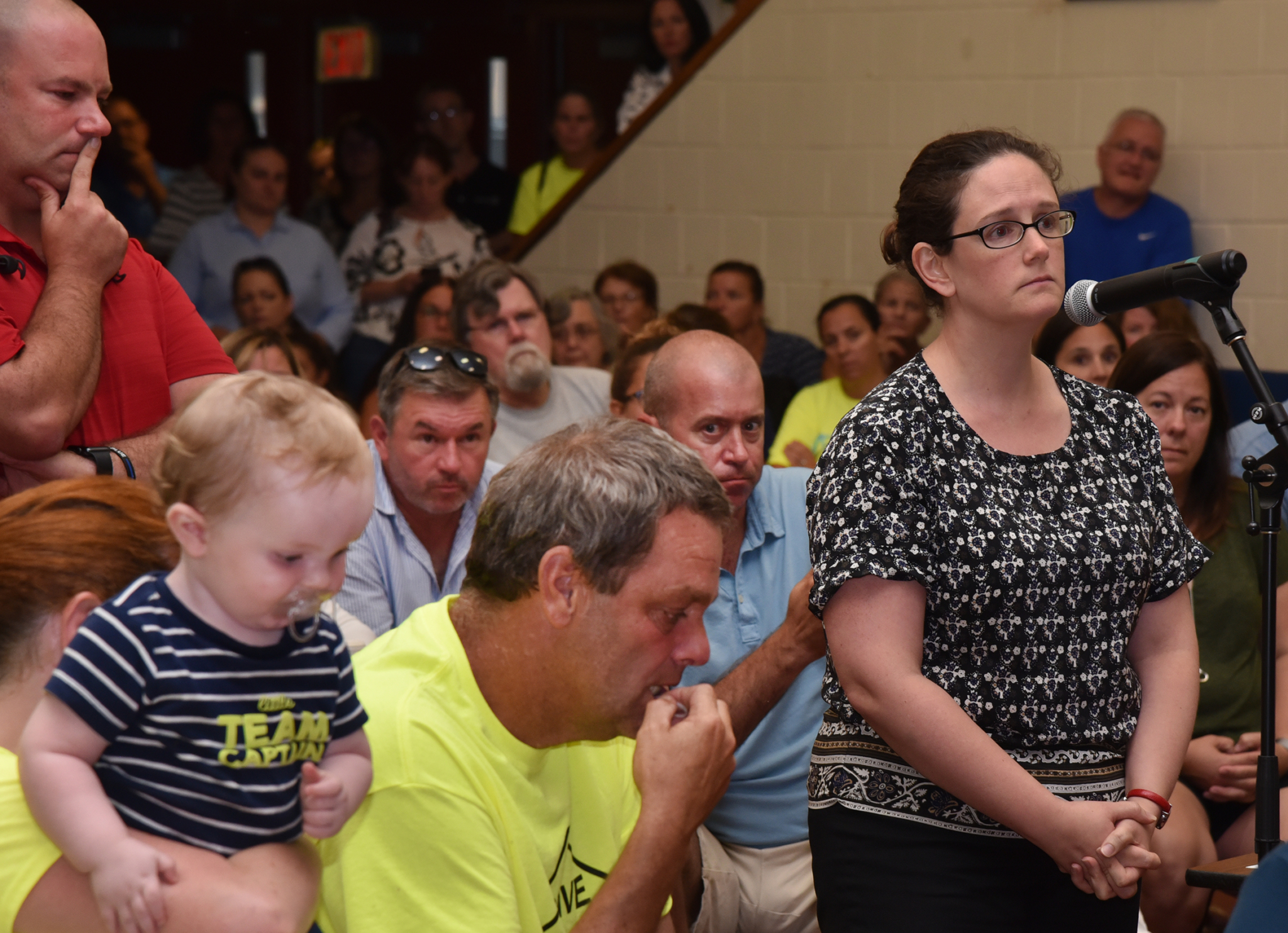
Ordinary citizens further emphasized that officials should not take a cookie cutter approach to different areas in South Boston, that the race track that L Street has become is unacceptable and their anger about the general situation. A number of residents declared to the officials that their plans need to recognize that the time has come for substantial change in enforcement, signing, traffic calming, and comprehensive planning. Some good ideas like having Police Cadets do required service on traffic patrol to increase safety on the streets, made economic sense as well as being long overdue. For in the end of the day if more officers are needed for enforcement, Boston needs to respond to the traffic monitoring as many other cities have successfully done in this nation. Added to many recommendations was the repeated call for public garages to relieve the streets of congestion, better commuter transportation linking, and a bottom to top evaluation of South Boston’s major intersections. Over and over citizens asked: “Why did this take so long? We have now reached beyond asking questions and have found a catalyst from a deep tragedy, and all eyes will be upon officials of all levels in the coming year. Stay tuned for more news coverage on this matter, as meetings and events unfold.

